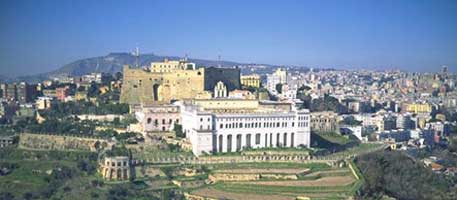Sant ' Elmo
 |
Together with the
adjacent Certosa di San Martino,
this forms an important group of buildings situated on the hill on
which the quarter of Vomero has
grown up.
Castel Sant'Elmo was also built on
the orders of Charles of Anjou: its
construction, in tuff, was begun in 1329 and completed in 1343
by the work of the architects Tino da Camaino,
Atanasio Primario and Francesco di Vito.
The building, whose architectural features from a distance resemble
those of the Castel dell'Ovo,
was one of the city's fortifications and was used above all to protect
it from invasions from the sea.
It was built where the Normans, in 1170, had a fort called Belforte
surrounded by rich vegetation.
All Naples' historic events involve Castel
Sant'Elmo.
The King Charles V, through the viceroy
Pedro de Toledo, rebuilt completely the castle by the work of
the Spanish architect Pier Luigi Scribā,
that designed the star-shaped plan of the castle.
It has witnessed numerous sieges, fierce disputes between the various
dominating powers, and repeated popular uprisings, including the now
legendary Masaniello revolt of 1647.
The old fort has risked destruction several times.
During the Second World War the Germans had intended to blow it up
before they left the city, changing their minds only at the last
minute.
The castle, which has now been restored, having been freed from its
use as a military prison, houses exhibitions of art and history and
also contains the Molaioli Library of Art
and a videotheque which supplies
information on all of the city's monuments.
The complex also contains the 16th century Church
of Sant'Elmo and the Chapel of
Santa Maria del Pilar (17th century).
From the communication trenches and the Castle's upper square there is
an extensive view over the city and Vesuvius,
the Neapolitan plain, and the marvellous gulf bounded by Capri
and the profile of the Phlegraen islands.
It is worthy to visit the Church of St.
Erasmo that has a rich floor in maiolica and tile. Behind
the altar there is the tomb of Pietro de Toledo,
a viceroy's relative and first lord of St.
Elmo.
In front of the entrance of the church there are the prisons where
were imprisoned, among many others : the Princess
Giovanna di Capua, Tommaso Campanella, Angelo Carasale the
architect of the San Carlo theatre and many revolutionaries: Mario
Pagano, Domenico Cirillo, Gennaro Sessa di Cassano, Francesco
Pignatelli, the Count Ettore Carafa, Luigia Sanfelice, Pietro
Colletta, Carlo Poerio, Silvio Spaventa and many others.